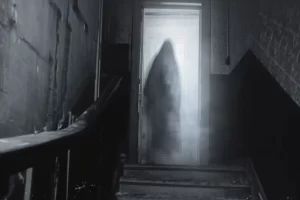
The Littlefield House
Posted: 01.28.2020 | Updated: 01.28.2020
The Littlefield House, with its unnerving amount of ghost tales and rumors circling it, is a prime example of the Austin feedback loop. The Alamo, St. Edward's, Shoal Creek, and all those other sites are haunted not by lowly spirits but by famous spooks... spooks that were once legends in life, and now seem to garner the same reputation in the after-life.The reason why Austin seems to be embedded in a constant stream of hauntings and horror movie antics is also the reason why the state of Texas is an ever ebullient fountain of legends and tales... because Texas, the Lone Star State, is home to some of the most extravagant and larger-than-life personalities this nation has ever bred.The History Of The Littlefield House.
The Littlefield - US National Register of Historic Places #70000767 - is a historic home found on the campus of the University of Texas at Austin. The home was constructed in 1893, by renowned architect James Wahrenberger. It was commissioned by the legendary Civil War veteran, cattle rancher, and businessman George Littlefield. George and his wife Alice would later be recognized as instrumental in the advance of UT. They were philanthropists and major benefactors to that Academi.The Littlefield House cost around 50k and was designed using Himalayan Cedar - imported straight from that region - in the artistical Victorian Style.The story of Littlefield and why many believe its haunting dates back to those first years when the house was occupied by George and Alice.The Story Of Alice.
Alice Payne Tillar was born in Virginia on April 10, 1846. At the age of 11, a prodigy, an avid painter, musician, and linguist Alice enrolled in Gonzales College. By then, she had acquired a rather vociferous reputation as an artist."Alice was known not only as a professional painter but a rather good storyteller. She had a charming personality and could carry a conversation with just about anyone. She knew several languages and was an incredibly inquisitive little girl. This desire of her's to better her education meshed perfectly well with her future husband's. This was partly the reason why they became such stalwart guardians of education in the city of Austin, donating to funds and projects dedicated to the growth of scholarly pursuits."
Alice met George W. Littlefield during their studies at Gonzales College.By September 1861, just before George left to fight on the Confederacy's side during the Civil War, the couple were engaged. After George returned and was subsequently discharged by the army on a count of injuries he suffered on the field, the couple finally wed. By all accounts, it was a happy marriage.Everything was running smoothly for almost 50 years."They had produced two children, both of whom died in infancy. Nowadays that would have been a blow, but back in those days, incidents of child mortality were rather high. We're talking about 30%. People were accustomed to it. It didn't dictate a person's level of bliss. Alice and George convinced that they could have any kids, dedicated their lives to their extended family. Their nieces and nephews. They ended up paying for the college education of all 29. And later on, they gave each one a job and a nice home."
In 1883, Alice and George moved to Austin and 10 years later they relocated to the Littlefield House.Then, when Alice hit the age of 65, the train hit a speedbump and things started to deteriorate. In 1912, for no apparent reason, Alice Littlefield developed an unexplained "nervous condition". Overnight, Alice began to have visions and delusions of doom. She was paranoid and convinced that her whole family would be murdered and that she would be kidnapped. These illusions and bouts of panic made her prone to fits of hysteria.George, at his wit's end, had to restrain Alice, and concurrently took her to a sanitarium for aid. The doctors advised him to intern Alice and allow them to take care of her condition.“I told him I would not think of leaving her with strangers, but I would carry her home, so I could look after her and care for her in comfort."
- George Littlefield.
"The tragedy of Alice and George steems from the fact that she did improve. She did manage to beat her nervous condition. When George died, she no longer had to fear that someone would murder him, this, in turn, liberated her from her paranoia. What ended up jailing her was her love for her husband. Ironically, she regained her sanity when that person was no longer on the board. When his physical wellbeing was no longer a concern."
Alice regained normal mental health and resumed an active social life. On January 9, 1935, at age 88, Alice died and was buried beside her husband at Oakwood Cemetery. Her gravestone reads: "Beloved wife of George W. Littlefield."The Haunting of Littlefield.
The interesting thing about the ghost that haunts this age-old construction is the fact that it is a rather busy specter. One peculiar wraith that has an unquenchable appetite for all things christened under her name. Alice Littlefield is said to haunt not only the Littlefield manor but also the residence hall/dormitory named after her at the University of Texas.Residents in that prestigious place constantly claim to hear unexpected noise and rattlings. They complain of incessant singing and moaning from the wall. The dormitory that holds her name is said to be protected by a "guardian angel" and more than one student can attest to Alice's ghost somehow protecting them. There are tales of students narrowly avoiding an accident, or bypassing bodily harm, on account of guiding hand helping them out.It has become a tradition of students in this part of UT to celebrate an annual seance in Alice's honor.Meanwhile, in the Littlefield Mansion, students and tourists constantly claim to feel Alice's ghostly presence. They are assailed by cold spots and odd sensations in the pit of their stomach."Folks claim to see her face peering through the different windows in the manor. Sometimes she's looking in while other times she's looking out. There are also reports of screams of fright or footsteps running up and down staircases."
The most iconic imagery to Alice's ghostly walkabout has to do with a portrait of her's hanging in the Littlefield House. The image infuses visitors with a rather eerie sensation. As if they are being judged or observed by Alice's oiled eyes.Book A Austin Ghosts Tour And See For Yourself
The bizarre find a welcome home here, but things turn macabre all too easily. Join us to see how Austin stays weird by its eerie hauntings.
The capital of the great state of Texas, Austin has also seen some of the bloodiest conflicts within the 50 States. Join us nightly to hear the tales of woe and misfortune, misadventure and heroism, and the spine-tingling real hauntings in Bat City.

